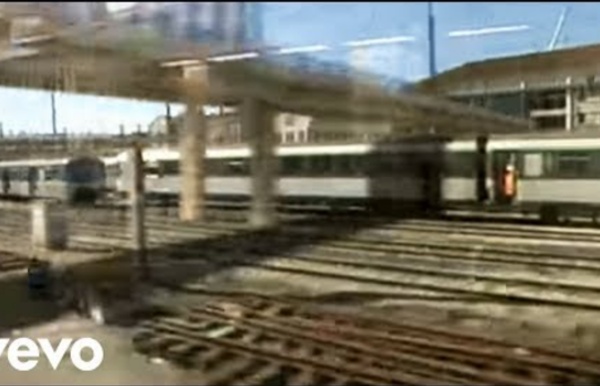



Visually Stunning Nature Footage Edit Set to “Hello Tomorrow” by Karen O Hey, Happy Earth Day! What better way to celebrate than watching remarkable footage of wildly random creepy crawly things in slow motion set to Hello Tomorrow by Karen O. You definitely need sound for this so turn up the volume for full effect. After a week of asking around I’ve learned only that the clip was edited together by Roen Horn using footage from somewhere I can’t identify. Update: Well that was quick.
john locke » Blog Archive » visualizing sound in processing This was the final applet in motion. Using the minim library for processing, each waveform is generated in realtime as the two sounds play over eachother creating a pretty chaotic sound, but there are some instances of overlapping patterns where the mashup works pretty well. In the third version of the code, the boolean of the two waveforms is generated, producing a new way to visualize the waveforms. View the youtube video here, but I really need to figure out a way to add sound to the video, silence doesn’t do it justice. import processing.dxf.*; import ddf.minim.analysis.*; import ddf.minim.*; FFT fftLog1; FFT fftLog2; Waveform myRects; Minim minim; AudioPlayer groove1; AudioPlayer groove2; boolean record; PFont font; PFont fontoutline; void setup(){ size(1200,600,P3D); noStroke(); minim = new Minim(this); groove1 = minim.loadFile(“groove_iggy.mp3″); groove2 = minim.loadFile(“groove_wagner.mp3″); groove1.loop();//repeat each song groove2.loop(); class Waveform{ float x,y,z; for(int i =0; i
さくらのブログ リクエストされたページは表示できません。 サーバのアクセス権限がありません。 [ TOPへ ] (C)Copyright SAKURA Internet Inc. リクエストされたページは表示できません。 [ TOPへ ] (C)Copyright SAKURA Internet Inc. AfterEffects でモーショングラフィックを作る この記事は2010年より前に書かれたものです。諸々の事情で情報が正しくない可能性があります。自己責任でご覧ください。 前回の記事に続き、またまた難題にぶつかりました。 AfterEffects では Flash のような感覚でモーショングラフィックは作れないということです。モーショングラフィックの構成要素として挙げられるのが音楽との同期。 RAM プレビューはデータを一旦メモリに溜め込んでから再生する機能なので、データの密度によっては数秒間プレビューするだけでも数分の遅延があったり、メモリの上限に達し数秒しかプレビューできないなんてことになったりする。 そこで考えたのが、一旦全体的な枠組みを作り、その段階で音楽との期をとってしまうという方法。 どちらにしろ重いことには変わらないので、メモリを増設することに。 4年もブランクあるのに、やたらと理想が高くなってしまい、全く納得いくものが作れそうにないという悲しい現実。 執筆者紹介 音の大きさ(振幅)に合わせて、素材を動かす その1 | はじめましての After Effects GarageBand講座からの引用ですが、音を構成する要素は以下の3つ: 音の高さ(周波数) 音の大きさ(振幅) 音色(波形) AEでは、音の大きさと素材のモーションを同期させることができます。 まずは、お手本動画で一例を紹介。(*´ω`*)が音楽に合わせてブルブルしているのを作るつもりです。なお、 サムネ的に無理って方は0:25以降見ないでね。 ではどうぞ。 AEのコンポジションは前奏に合わせて30秒あれば十分。 次に曲(オーディオレイヤー)を選択して、 ●アニメーション→キーフレーム補助→オーディオをキーフレームに変換 すると「オーディオ振幅」というヌルレイヤーが生成されます。 オーディオ振幅レイヤーを選択後、「u」をクリックして展開しておきましょう。 つづいて、素材の処理です。 (*´ω`*).aiレイヤーのスケールプロパティを選択して、 ●アニメーション→エクスプレッションを追加 コンポジションパネルが真っ暗になりますが、これはエクスプレッションの設定待ちを表してます。 すると、エクスプレッションテキストフィールド(↓の赤枠)にエクスプレッションが記述されるので、フィールド外をクリックして確定します。 設定されたエクスプレッションは、temp = thisComp.layer(“オーディオ振幅”).effect(“両方のチャンネル”)(“スライダー”); [temp, temp] これでひとまず完成。 なんか小さい… これは、音の大きさ(振幅)自体が小さいから。 書き換え後のエクスプレッションは、temp = thisComp.layer(“オーディオ振幅”).effect(“両方のチャンネル”)(“スライダー”)*10; [temp, temp] 「*10」というのは「×10」の意味。 でも、なんかお手本の動画と違うんだなー こっちのほうは動きがすごい激しいというか暴れん坊というか。 オーディオ振幅レイヤー(両方のレイヤー)のスライダー横のグラフマークをクリックしてから、グラフエディタをクリックしてみると… キーフレーム化された振幅が表示されます。 その範囲は-250〜+550。 さて、どうしたものか。
音のデータとAfter Effects その1 at AEP Project 音のデータとAfter Effects 「音、音楽のデータを扱う時After Effectsは使いにくいなぁ・・・」そう思ったことはありませんか? Premiereはスペース押すだけで簡単に映像と一致して見れるのに、と普段よく思います。 そこで、AE標準の機能をおさらいしつつ、音のデータをAfter Effectsで扱う時に知っておくと、ちょっと便利な小ネタやスクリプトをご紹介したいと思います。(ここではWindows版 CS5でご紹介します) さて、まずはAE標準の機能から。 波形のみで作業することはほとんどないでしょうから、サウンドのプレビューにはテンキーの「.」。 Altを押しながら「.」でワークエリアの初めからプレビューしてくれます。 そういう時は、Ctrlキーを押しながらインジケーターをドラッグしましょう。 次も標準で付いている機能の、「オーディオをキーフレームに変換」する機能です。 オーディオレイヤーを右クリックし、「キーフレーム補助」から「オーディオをキーフレームに変換」を選択します。 すると、オーディオを自動で解析してその値をキーフレームに打ち込んでくれます。 後はエクスプレッションなりで繋いでやると、簡単に音と同期した映像を作ることができます。 また、標準エフェクトの「オーディオウェーブフォーム」、「オーディオスペクトラム」、Trapcodeの「Sound Keys」などはレイヤー指定だけで簡単にオーディオと同期した映像が作れます。 さて、次は知っておくとちょっと便利なスクリプトなどを紹介していきます。 オーディオに合わせてマーカーをつけたい レイヤーが多くなるとオーディオのレイヤーを開くわけにもいかなくなったりします。 先ほどのオーディオ振幅レイヤーを元に、自動でマーカー付けをしてくれます。 マーカーは既存のレイヤーに乗せるか、新規レイヤーにするかを選べます。 このAudioToMarkersは「Name Your Own Price」となっているので、試してみたい方はいかがでしょうか。 このスクリプトを入れるときは、AEの言語に合わせて中身を書き換える必要があるので注意してください。 つけたマーカーを活用したい マーカーをつけたはいいけどそれだけじゃ意味がない、もっと便利なものはないの? これはマーカーを元にシーンを切り出して、子コンポ自動生成してくれるという優れモノです。 その2へ
Project Eden In this post, I'll be describing in more detail how the CG Earth is constructed. The whole planet was broken down into several key components: land, water, clouds, atmosphere and an atmospheric "rim". The atmosphere has two components because it's not a true volumetric simulation, but a kind of hack ^^; Land Nothing fancy here that's not been done for decades. A simple sphere primitive with polar (spherical) UV projection so that the Blue Marble textures can be wrapped around it. Water This is just another sphere primitive with an ocean shader applied. Clouds After much experimentation with various volumetric hacks, I eventually settled upon the same age old technique everyone else is using - a sphere (surprise, surprise) mapped with transparency data from NASA's cloud texture, with the same cloud map doubling as a displacement map to give the clouds actual thickness. Atmosphere and Rim Another key component that makes or breaks the look of a CG planet is the atmosphere. Size Matters
Night Lights 2012 - Flat map acquired April 18 - October 23, 2012download large image (776 KB, JPEG, 3600x1800) acquired April 18, 2012download GeoTIFF file (3 MB, TIFF, 3600x1800) acquired April 18, 2012download large image (7 MB, JPEG, 13500x6750) acquired April 18, 2012download GeoTIFF file (39 MB, TIFF, 13500x6750) acquired April 18, 2012download large image (9 MB, JPEG, 13500x13500) acquired April 18, 2012download GeoTIFF file (70 MB, TIFF, 13500x13500) acquired April 18, 2012download large image (2 MB, JPEG, 13500x13500) acquired April 18, 2012download GeoTIFF file (9 MB, TIFF, 13500x13500) acquired April 18, 2012download large image (10 MB, JPEG, 13500x13500) acquired April 18, 2012download GeoTIFF file (69 MB, TIFF, 13500x13500) acquired April 18, 2012download large image (7 MB, JPEG, 13500x13500) acquired April 18, 2012download GeoTIFF file (47 MB, TIFF, 13500x13500) acquired April 18, 2012download large image (22 MB, JPEG, 13500x13500) acquired April 18, 2012download GeoTIFF file (151 MB, TIFF, 13500x13500)
NASA-NOAA Satellite Reveals New Views of Earth at Night Scientists unveiled today an unprecedented new look at our planet at night. A global composite image, constructed using cloud-free night images from a new NASA and National Oceanic and Atmospheric Administration (NOAA) satellite, shows the glow of natural and human-built phenomena across the planet in greater detail than ever before. This image of the continental United States at night is a composite assembled from data acquired by the Suomi NPP satellite in April and October 2012. The image was made possible by the satellite's "day-night band" of the Visible Infrared Imaging Radiometer Suite (VIIRS), which detects light in a range of wavelengths from green to near-infrared and uses filtering techniques to observe dim signals such as city lights, gas flares, auroras, wildfires and reflected moonlight.Credit: NASA Earth Observatory/NOAA NGDC› Larger image› High-resolution download and more information → [image-62][image-76] "The night is nowhere as dark as we might think," Miller said.
Time-Lapse Videos This clickable map organizes all of the existing time-lapse sequences into geographical regions. These videos are organized to both aid in searching for a desired area of the Earth, and to break down the volume of the existing time-lapse sequences. Each region below is separated by regions around the world, as well as links below the clickable map to the "Aurora Borealis and Australis" and "Special Videos". The newest release of time-lapse sequences will be posted just below these two sections. Due to a very active crew schedule, the current crew has been unable to take time-lapse photography. Latest videos from the crew Aurora Australis over the Ocean This video was taken by the crew of Expedition 43 on board the International Space Station. Date posted: 2015/04/29 Nighttime over the Mediterranean This video was taken by the crew of Expedition 43 on board the International Space Station. Over the Mediterranean and Europe at Night Northern India at Night City Lights of Europe at Night